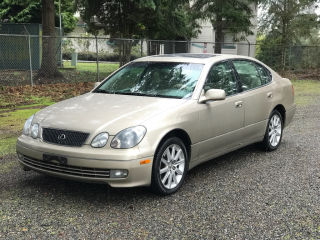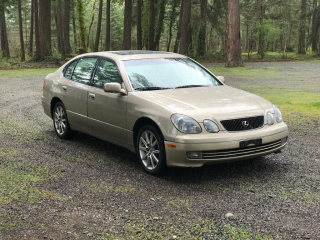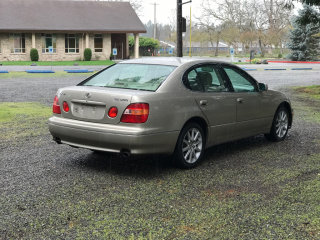The Good
The 1999 Lexus GS offers a compelling blend of advantages, appealing to both heart and mind. Its performance, especially the V8 in the GS 400, provides an exhilarating drive, while its legendary Lexus reliability ensures peace of mind. Owners appreciate its plush, quiet cabin comfort and timeless design. Good efficiency for its class and strong long-term value make it a practical choice, combining luxury with enduring dependability.
The Bad
While generally robust, the 1999 Lexus GS has some known weaknesses to watch out for. Common issues include aging suspension components, which can lead to a less refined ride, and occasional dashboard pixelation problems. Brake wear can be a recurring item, and the original navigation system, if present, is severely outdated. These are often age-related rather than design flaws.
1999 Lexus GS: Quick Overview
The 1999 Lexus GS offered impressive specifications for its era, blending luxury with potent performance. Here's a summary:
- Engine Options:
- GS 300: 3.0-liter 2JZ-GE DOHC inline-six engine.
- GS 400: 4.0-liter 1UZ-FE DOHC V8 engine.
- Horsepower:
- GS 300: 220 horsepower.
- GS 400: 300 horsepower.
- Fuel Economy (EPA estimated):
- GS 300: Approximately 18 city / 24 highway miles per gallon.
- GS 400: Approximately 17 city / 23 highway miles per gallon.
- 0-60 MPH Times:
- GS 300: Around 7.8-8.0 seconds.
- GS 400: Impressive 5.7-6.0 seconds, making it one of the quickest sedans in its class at the time.
- Towing Capacity: The 1999 Lexus GS was not primarily designed or rated for significant towing. Any capacity would be minimal and require specific equipment, generally not exceeding 2,000 lbs. It's best considered unsuitable for towing.
- Trim-Level Features:
- Standard (GS 300 & GS 400): Both trims featured a high level of luxury. Standard equipment included automatic climate control, power windows, locks, and mirrors, cruise control, a premium audio system, power-adjustable front seats, leather upholstery (often standard or a popular option), and 4-wheel anti-lock brakes (ABS). Traction control was also standard.
- GS 300 Specifics: Typically came with 16-inch alloy wheels.
- GS 400 Specifics: Distinguished by its more powerful V8 engine, it usually featured larger 17-inch alloy wheels. It also often included more standard luxury items like High-Intensity Discharge (HID) headlamps and Vehicle Stability Control (VSC), which was optional on the GS 300. Optional features across both trims included a power moonroof, heated front seats, and a CD changer. The navigation system was an available option, though primitive by modern standards.
1999 Lexus GS Specifications
Vehicle Information
| Year | 1999 |
| Make | Lexus |
| Model | GS |
| Trim | - |
| Style | - |
| Type | Sedan |
| Category | Compact Car |
Manufacturing Details
| Made In | Japan |
| Manufacturing City | - |
Dimensions
| Doors | - |
| Curb Weight | - |
| Gross Vehicle Weight Rating | - |
| Overall Height | - |
| Overall Length | - |
| Overall Width | - |
| Wheelbase Length | - |
| Standard Seating | - |
Engine & Performance
| Engine | 3.5L V6 |
| Engine Size | 3.5L |
| Engine Cylinders | 6 |
| Transmission | - |
| Transmission Type | - |
| Transmission Speeds | - |
| Drivetrain | Rear-Wheel Drive |
Additional Features
| Anti-Brake System | - |
| Steering Type | - |
Pricing
| Manufacturer Suggested Retail Price (MSRP) | - |
| Invoice Price | - |
| Delivery Charges | - |
Vehicle History Report
Specifications
History
Events
History Check
Check
Check
Check
Check
Listings
Recalls
Check
Analysis
What Problems Does the 1999 Lexus GS Have?
The 1999 Lexus GS is renowned for its excellent long-term reliability, a hallmark of the Lexus brand. However, as with any vehicle approaching or exceeding two decades of age, certain frequently reported problems and maintenance concerns emerge, typically due to wear and tear rather than inherent design flaws.
- Dashboard Display Pixelation: One of the most common cosmetic issues is the degradation of the LCD screens for the climate control and radio, where pixels fail and make the display difficult to read. This is a prevalent issue across these model years.
- Suspension Component Wear: Over time, bushings, ball joints, and struts can wear out, leading to clunking noises, a 'floaty' ride, or uneven tire wear. This is a standard aging process for any vehicle.
- Power Steering Leaks: Hoses and the power steering pump itself can develop leaks. Owners often report having to top off the power steering fluid periodically.
- Oxygen Sensor Failure: Malfunctioning oxygen sensors are a relatively common cause of a "Check Engine" light, potentially affecting fuel efficiency and emissions.
- Starter Motor Replacement: For both the GS 300 and GS 400, replacing the starter motor is a significant job due to its location under the intake manifold, leading to higher labor costs.
- Timing Belt Service: The GS 300 and GS 400 both utilize timing belts, which require replacement every 90,000 miles or 7 years, along with the water pump. Neglecting this critical service can lead to catastrophic engine damage.
- Brake System Wear: Owners occasionally report premature brake pad wear or warped rotors, especially if aftermarket components are used or if the vehicle is driven aggressively.
- Window Regulator Issues: Some owners have experienced failures of the power window regulators, requiring replacement.
Regarding recalls, specific to the 1999 model year, there have been some minor campaigns. For instance, some models within this generation were part of a larger recall campaign related to airbag inflators (though not the widespread Takata recall). It is always advisable for prospective buyers to check the National Highway Traffic Safety Administration (NHTSA) website using the vehicle's VIN for any open recalls, as these should be addressed by a Lexus dealer free of charge. Overall, while these issues exist, proactive maintenance and addressing problems as they arise can ensure the GS continues to be a very reliable long-term vehicle.
How long will the 1999 Lexus GS last?
What Technology & Safety Features are Included?
The 1999 Lexus GS, while a product of its era, offered a respectable array of built-in technology, entertainment, and safety features that contributed to its luxury appeal.
Built-in Tech & Entertainment:
- Automatic Climate Control: A sophisticated automatic climate control system, often with dual-zone capability, provided comfortable cabin temperatures.
- Premium Audio System: Standard was a high-quality audio system, typically featuring AM/FM radio and a cassette player, with an optional in-dash or trunk-mounted CD changer.
- Power Amenities: Full power windows, door locks, and side mirrors were standard, along with power-adjustable front seats, often with memory functions for the driver.
- Optional Navigation System: An optional, CD-ROM based navigation system was available, though its functionality and graphical interface are primitive by today's standards.
- Other Luxuries: Leather upholstery, a power tilt-and-telescoping steering wheel, and cruise control were standard or widely available. A power moonroof was a popular optional extra.
Driver-Assistance Features:
- Traction Control (TRAC): Standard on both trims, TRAC helped prevent wheel spin under acceleration.
- Vehicle Stability Control (VSC): An early form of electronic stability control, VSC was standard on the GS 400 and an important optional feature for the GS 300, helping drivers maintain control during challenging maneuvers.
Safety Features:
- Airbags: Dual front airbags were standard, complemented by front seat-mounted side-impact airbags, significantly enhancing occupant protection.
- Braking System: A 4-wheel Anti-lock Braking System (ABS) was standard, providing confident stopping power.
- Seatbelts: Three-point seatbelts for all five occupants, with front seatbelt pretensioners and force limiters.
- Structure: The GS boasted a rigid body structure designed for energy absorption in the event of a collision.
Crash-Test Ratings:
According to the National Highway Traffic Safety Administration (NHTSA) crash tests for the 1999 Lexus GS (with side airbags):
- Frontal Driver Side: 4 out of 5 stars
- Frontal Passenger Side: 4 out of 5 stars
- Side Impact Front Seat: 5 out of 5 stars
- Side Impact Rear Seat: 4 out of 5 stars
These ratings were considered very good for a vehicle of its class and time, demonstrating strong passive safety capabilities. IIHS ratings for this specific year are not readily available in the modern format.
What Colors Options are Available?
1999 Lexus GS Prices and Market Value
1999 Lexus GS Cost of Ownership
1999 Lexus GS Fuel Efficiency
1999 Lexus GS Insurance
reasonable repair costs.
How Does the 1999 Lexus GS Compare to Other Sedan?
The 1999 Lexus GS squared off against formidable rivals in the mid-size luxury sedan segment, primarily the BMW 5 Series (E39), Mercedes-Benz E-Class (W210), and Audi A6 (C5). Here's how it stacked up:
- Performance: The GS 400, with its 300 hp V8, was a genuine performance contender, often matching or even outperforming the Mercedes E430 and BMW 540i in straight-line acceleration (0-60 mph). The GS 300's inline-six offered smooth, competent power, competitive with the BMW 528i and Mercedes E320. While the GS offered a sporty ride for a Lexus, the BMW E39 5 Series generally held the edge for ultimate driving dynamics and steering feel, appealing more to the enthusiast driver.
- Features: All rivals offered a high level of luxury, including leather, automatic climate control, and premium audio. The Lexus GS often provided a comprehensive list of standard features for its price point, sometimes including amenities that were optional on base German models. The build quality and material choices in the GS were top-notch, enduring well over time.
- Reliability: This is arguably where the Lexus GS established a dominant lead. Its long-term reliability and lower overall maintenance costs were significantly better than its European counterparts. BMW E39s, while fantastic to drive, were known for cooling system issues, electrical gremlins, and higher component costs. Mercedes W210s faced concerns like rust (especially in certain regions), electrical malfunctions, and more complex, expensive repairs. Audi A6s could be prone to transmission issues and equally complex electronics. The GS was the undisputed champion in dependability.
- Price: When new, the GS was competitively priced, often offering comparable features for slightly less than a similarly equipped German rival. In the current used market, while all have depreciated significantly, well-maintained GS models, especially the V8, tend to command a slight premium over their German contemporaries due to their reputation for bulletproof reliability and lower running costs.
Alternatives:
- For Superior Driving Dynamics: The BMW E39 5 Series (530i or 540i) remains a benchmark for driver engagement, though be prepared for potentially higher maintenance.
- For Ultimate Comfort (and brand prestige): The Mercedes-Benz E-Class (W210) offers a more traditional luxury experience, but often with higher long-term repair expenses.
- Similar Alternatives: The Acura TL (especially Type-S for later years) offers Japanese reliability and a sporty feel, while the Infiniti I30/Q40 provided another solid domestic luxury option.



